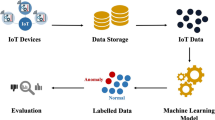Abstract
The online anomaly detection has been propounded as the key idea of monitoring fault of large-scale sensor nodes in Internet of Things. Now, the exciting progresses of research have been made in online anomaly detection area. However, the highly dynamic distributing character of Internet of Things makes the anomaly detection scheme difficult to be used in online manner. This paper presents a new online anomaly learning and detection mechanism for large-scale service of Internet of Thing. Firstly, our model uses the reversible-jump MCMC learning to online learn anomaly-free of dynamics network and service data. Next, we perform a structural analysis of IoT-based service topology by network utility maximization theory. The results of experiment demonstrate the method accuracy in forecasting dynamics network and service structures from synthetic data.




Similar content being viewed by others
References
Atzori L, Lera A, Morabito G (2010) The internet of things: a survey. Comput Netw 54(15):2787–2805
Miorandi D, Sicari S, De Pellegrini F, Chlamtac I (2012) The internet of things: vision, applications and research challenges. Ad Hoc Netw 10(7):1497–1516
Xie M, Hu JK, Han S, Chen HH (2013) Scalable hypergrid k-NN-based online anomaly detection in wireless sensor networks. IEEE Trans Parallel Distrib Syst 24(8):1661–1670
Xie M, Han S, Tian B, Parvin S (2011) Anomaly detection in wireless sensor networks: a survey. J Netw Comput Appl 34(4):1302–1325
West SR, Guo Y, Wang XR (2011) Automated fault detection and diagnosis of HVAC subsystems using statistical machine learning. In: 12th international conference of the International Building Performance Simulation Association
Warriach EU, Aiello M, Tei K (2012) A machine learning approach for identifying and classifying faults in wireless sensor networks. In: IEEE 15th international conference on computational science and engineering
Zhang Y, Meratnia N, Havinga PJM (2010) Outlier detection techniques for wireless sensor networks: a survey. IEEE Commun Surv Tutor 12(2):159–170
Yao Y, Sharma A, Golubchik L, Govindan R (2010) Online anomaly detection for sensor systems: a simple and efficient approach. Perform Eval 67(11):1059–1075
Sagha H, Bayati H, Milln JR, Chavarriaga R (2013) Online anomaly detection and resilience in classifier ensembles. Pattern Recognit Lett 34(15):1916–1927
Salem O, Liu YN, Mehaoua A (2013) A lightweight anomaly detection framework for medical wireless sensor networks. In: IEEE Wireless Communications and Conference (WCNC): service and applications
Ma X, Yang D, Tang S, Luo Q, Zhang D, Li S (2004) Online mining in sensor networks. In: IFIP international conference on network and parallel computing, vol 3222, pp 544–550
Subramaniam S, Palpanas T, Papadopoulos D, Kalogerakiand V, Gunopulos D (2006) Online outlier detection in sensor data using nonparametric models. In: Very Large Data Bases, VLDB
Martincic F, Schwiebert L (2006) Distributed event detection in sensor networks. In: Proceedings of the international conference on systems and networks communication, pp 43–48
Alam S, Noll J (2011) Virtualizing sensor for the enablement of semantic-aware internet of things ecosystem. Int J Des Anal Tools Circuits Syst 3(1):41–51
Azizi E (2013) Joint learning of modular structures from multiple data types. In: NIPS workshop of frontiers of network analysis: methods, models, and applications
Azizi E, Airoldi E, Galagan J (2014) Learning modular structures from network data and node variables. In: International conference on machine learning
Chiang M, Low SH, Calderbank AR, Doyle JC (2007) Layering as optimization decomposition: a mathematical theory of network architectures. Proc IEEE 95(1):255–312
Wang J, Li L, Low SH, Doyle JC (2005) Cross-layer optimization in TCP/IP networks. IEEE/ACM Trans Netw 13(3):582–595
Grant M, Boyd S (2008) CVX: Matlab software for disciplined convex programming. Prentice Hall, New York
Acknowledgments
The author also would like to thank anonymous editor and reviewers who gave valuable suggestion that has helped to improve the quality of the manuscript. This research has been supported by the Project for 2015 National Key Technologies RD Program No. 2015BAH04F01.
Author information
Authors and Affiliations
Corresponding author
Rights and permissions
About this article
Cite this article
Wang, J., Kuang, Q. & Duan, S. A new online anomaly learning and detection for large-scale service of Internet of Thing. Pers Ubiquit Comput 19, 1021–1031 (2015). https://doi.org/10.1007/s00779-015-0874-8
Received:
Accepted:
Published:
Issue Date:
DOI: https://doi.org/10.1007/s00779-015-0874-8




